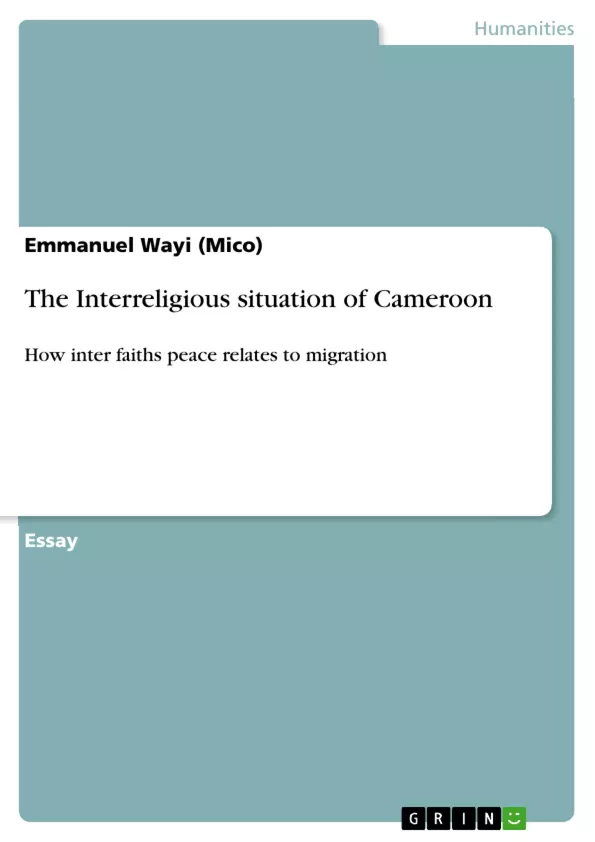Migration in Cameroon in general has been caused by various factors. Of recent, there seem to be the feeling that though some people say that Cameroon is at peace there is a boiling pot. The interfaith situation of the country is such that has nursed tension and distrust for so long that if care is not taken, it may one day results to a terrible crisis.
This paper tries to show that though the various religions in Cameroon try to promote peace, the tension within individual faiths may one day cause a new problem. Thus, there needs to be a tilt towards the inside to subdue all internal conflict before a true inter religious dialogue can exist in that country.
Table of Contents
- INTRODUCTION
- RELATING TO MIGRATION IN CAMEROON
- CONCLUSION
Objectives and Key Themes
This paper aims to provide a summary examination of the interreligious situation in Cameroon, focusing on the relationships between different religious groups and how these dynamics relate to migration. While acknowledging the complexities and ambiguities of the situation, the paper highlights ongoing efforts towards peaceful interfaith dialogue.
- Intra-religious tensions within Christianity and Islam
- Relationships between Christians, Muslims, and traditional religious practitioners
- Christian-Muslim relations and interfaith dialogue initiatives
- The influence of migration on interreligious dynamics
- The impact of Boko Haram insurgency on interfaith relations
Chapter Summaries
INTRODUCTION: This introductory chapter sets the stage by describing Cameroon's religious landscape, highlighting the coexistence of Christianity (63%), Islam (22%), and traditional religions (14%). It emphasizes the ambiguous and potentially volatile nature of the interreligious situation, framing the paper as a summary analysis of this complexity, drawing on document analysis and the author's personal experience. The chapter outlines the structure of the paper, focusing on the internal dynamics within each faith before examining interfaith relations.
RELATING TO MIGRATION IN CAMEROON: This chapter delves into the specific relationships between different religious groups in Cameroon. It explores internal divisions within both Islam (Sufism, Sunni, Shia, Takfir, Wahhabism) and Christianity (mainline churches vs. Pentecostal churches), highlighting the tensions and distrust that exist within these groups. The chapter further analyzes the relationships between these faiths and traditional religions, noting varying degrees of acceptance and integration. The central focus is on Christian-Muslim relations, examining the efforts of interfaith dialogue organizations and acknowledging the challenges these organizations face, such as a lack of government support and limited public impact. The chapter also discusses the impact of Boko Haram's activities and the resulting fear of escalating religious conflict.
Keywords
Cameroon, interreligious relations, Islam, Christianity, traditional religions, migration, interfaith dialogue, Boko Haram, Wahhabism, Sufism, Pentecostalism, religious conflict, peacebuilding.
Cameroon Interreligious Relations: A Summary Analysis - FAQ
What is the main topic of this document?
This document provides a summary analysis of the interreligious situation in Cameroon, focusing on the relationships between different religious groups and how these dynamics relate to migration. It examines intra-religious tensions, interfaith relations, the impact of Boko Haram, and efforts towards peaceful interfaith dialogue.
What are the main religious groups in Cameroon discussed in this document?
The document primarily focuses on Christianity (63%), Islam (22%), and traditional religions (14%) in Cameroon. Within Christianity, it distinguishes between mainline churches and Pentecostal churches. Within Islam, it mentions Sufism, Sunni, Shia, Takfir, and Wahhabism.
What are the key themes explored in the analysis?
Key themes include intra-religious tensions within Christianity and Islam, relationships between Christians, Muslims, and traditional religious practitioners, Christian-Muslim relations and interfaith dialogue initiatives, the influence of migration on interreligious dynamics, and the impact of the Boko Haram insurgency on interfaith relations.
What is the methodology used in this analysis?
The analysis draws upon document analysis and the author's personal experience. It presents a summary examination of the complex and potentially volatile interreligious situation in Cameroon.
What are the major internal divisions within the religious groups discussed?
The document highlights tensions and distrust within both Christianity (between mainline churches and Pentecostal churches) and Islam (between Sufism, Sunni, Shia, Takfir, and Wahhabism). These internal divisions complicate interfaith relations.
What role does migration play in the interreligious dynamics of Cameroon?
The document explores how migration influences the interreligious dynamics in Cameroon, though the specifics of this influence aren't detailed in the provided summary.
What is the impact of Boko Haram on interfaith relations in Cameroon?
Boko Haram's activities are discussed as a significant factor contributing to fear and the potential for escalating religious conflict in Cameroon.
What efforts are made towards interfaith dialogue in Cameroon?
The document mentions the efforts of interfaith dialogue organizations, but also acknowledges the challenges they face, including a lack of government support and limited public impact.
What is the overall conclusion or takeaway from this analysis?
The document offers a summary overview of the complex and potentially volatile interreligious situation in Cameroon, highlighting both the tensions and the ongoing efforts towards peaceful interfaith dialogue, acknowledging the limitations of a summary analysis.
What keywords are associated with this document?
Cameroon, interreligious relations, Islam, Christianity, traditional religions, migration, interfaith dialogue, Boko Haram, Wahhabism, Sufism, Pentecostalism, religious conflict, peacebuilding.
- Quote paper
- Emmanuel Wayi (Mico) (Author), 2016, The Interreligious situation of Cameroon, Munich, GRIN Verlag, https://www.grin.com/document/336988



